First TPU Based on CO2 Technology Makes Debut
The polyols used in Covestro's new TPU help reduce the material's carbon footprint.
What appears to be the first TPU that is based on carbon dioxide (CO2) technology is newly available from Covestro. The company first developed and is now marketing its new cardyon polyether carbonate polyols, which are produced with the aid of CO2.
With the recent launch of Desmopan 37385A the company now offers the first representative of a new series of TPUs containing the new polyether carbonate polyols based on CO2 technology.
Compared to conventional TPU materials, the new TPU products have a lower carbon footprint and help close the carbon cycle. They also conserve fossil resources and, unlike many bio-based materials, do not compete with food production. Georg Fuchte, Covestro’s TPU expert, noted ,“With the new TPU, our customers can reduce the carbon footprint of their products and as a result play a pioneering role in sustainability vis-à-vis their competitors. This is especially true for companies in the consumer goods industry, which often manufacture products with a short lifespan.”
Desmopan 37385A has a 85 Shore A hardness, and its mechanical properties are reportedly at least at the level of conventional TPU grades of similar hardness, while exceeding them in some cases. For example, it has a tensile strength of 36 megapascals (5221.3671 psi) and its elongation at break reaches 660 percent. Although it is designed for extrusion, is also suitable for injection molding. According to Fuchte, the spectrum of applications covers typical end-uses of conventional TPU grades with comparable hardness ranging from soles and upper shoe components to sportswear, handles, knobs, and packaging for sensitive electronics.
Covestro plans to expand the new TPU series with variants of different hardnesses. A product with a hardness of 95 Shore A, for example, whose melt cures rapidly during processing, is well advanced in development. “We are thus targeting applications in which economic production in short cycle times is particularly important,” explains Fuchte.
Related Content
-
Measuring Multilayer Plastic Containers Made Easier With Today's Ultrasonic Gauges
Ultrasonic gauge technology has evolved to simplify measurement of very thin layers in plastic containers. Today’s gauges with high-frequency capabilities and specialized software can make multilayer container measurement quick and easy for ordinary users.
-
First Water Bottles With Ultrathin Glass Coating
Long used for sensitive juices and carbonated soft drinks, KHS Freshsafe PET Plasmax vapor-deposited glass coating is now providing freshness and flavor protection for PET mineral water bottles.
-
Flexible-Film Processor Optimizes All-PE Food Packaging
Tobe Packaging’s breakthrough was to create its Ecolefin PE multilayer film that could be applied with a specialized barrier coating.


















